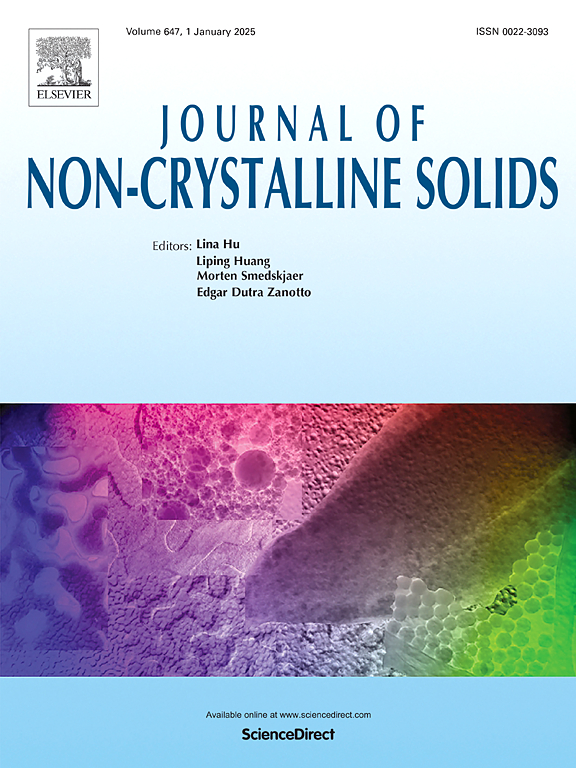(CaO-SiO2)- xtio2基结晶器助焊剂微观组织的原位高温拉曼光谱分析
IF 3.5
3区 材料科学
Q1 MATERIALS SCIENCE, CERAMICS
引用次数: 0
摘要
在高钛钢的连铸过程中,传统的基于cao - sio2的助焊剂与钢液发生强烈反应,形成CaO-SiO2-TiO2渣。这种转变增加了结晶度,提高了熔点和断裂温度,同时降低了炉渣粘度。利用旋转粘度、XPS和原位高温拉曼光谱,本研究阐明了这些变化背后的结构-性能关系。随着TiO2/SiO2质量比的增加,黏度从0.42 Pa·s降低到0.12 Pa·s,熔点从945℃提高到1187℃,熔断温度从1151℃提高到1212℃。渣的形貌由玻璃结构(N1, N2)转变为高熔点钙钛矿(CaTiO3)析出的晶体(N3)。在结构上,TiO2/SiO2比的增加使硅酸盐网络解聚,增加了非桥氧(NBO)和游离氧(FO)的含量。在较低的TiO2水平下,TiO2作为网络修饰剂,形成与NBO相关的解聚[TiO6]8−八面体。在较高的含量下,TiO2作为网络形成物,QSi2和QSi3硅酸盐结构单元减少,取而代之的是[TiO4]4−和[Ti2O6]4−簇,形成复杂的Ti-O网络。与Si-O四面体相比,这些体积更大、键能更低的Ti-O单元形成了更宽的结构间隙和共边构型,促进了氧离子的占用率,进一步提高了NBO和FO的浓度。这种网络解聚改善了渣的流动性,在N3中观察到最低的粘度。而[TiO6]8−八面体含量的增加促进了钙钛矿的成核,提高了矿渣的结晶度。这项工作为设计高钛钢的结晶剂提供了关键的理论见解,以非/低反应性和抑制结晶为目标。本文章由计算机程序翻译,如有差异,请以英文原文为准。
Microstructure analysis of (CaO-SiO2)-xTiO2-based mold flux microstructures using in situ high temperature Raman spectroscopy
During continuous casting of high-Ti steels, conventional CaO-SiO2-based mold flux reacts strongly with molten steel, forming CaO-SiO2-TiO2 slags. This transformation increases crystallinity and raises the melting and break temperatures, while reducing slag viscosity. Using rotational viscometry, XPS and in situ high-temperature Raman spectroscopy, this study clarified the structure-property relationships underlying these changes. Increasing the TiO2/SiO2 mass ratio decreased viscosity from 0.42 Pa·s to 0.12 Pa·s, while increasing the melting temperature from 945 °C to 1187 °C and the break temperature from 1151 °C to 1212 °C. Slag morphology transitioned from a glass structure (N1, N2) to a crystals (N3) with high-melting-point perovskite (CaTiO3) precipitated. Structurally, increased TiO2/SiO2 ratios depolymerized the silicate network, increasing non-bridging oxygen (NBO) and free oxygen (FO) content. At lower TiO2 levels, TiO2 acted as a network modifier, forming depolymerized [TiO6]8− octahedra associated with NBO. At higher contents, TiO2 functioned as a network former, where and silicate structural units decreased and replaced by [TiO4]4− and [Ti2O6]4− clusters, forming complex Ti-O networks. These Ti-O units, with larger volumes and lower bond energies than Si-O tetrahedra, created wider structural gaps and edge-sharing configurations, facilitating oxygen ion occupancy rate, further increasing NBO and FO concentrations. This network depolymerization improved slag flowability, with the lowest viscosity observed in N3. However, rising [TiO6]8− octahedra content promoted perovskite nucleation, increasing slag crystallinity. This work provided critical theoretical insight for designing mold fluxes for high-Ti steel, targeting non-/low-reactivity and suppressed crystallization.
求助全文
通过发布文献求助,成功后即可免费获取论文全文。
去求助
来源期刊

Journal of Non-crystalline Solids
工程技术-材料科学:硅酸盐
CiteScore
6.50
自引率
11.40%
发文量
576
审稿时长
35 days
期刊介绍:
The Journal of Non-Crystalline Solids publishes review articles, research papers, and Letters to the Editor on amorphous and glassy materials, including inorganic, organic, polymeric, hybrid and metallic systems. Papers on partially glassy materials, such as glass-ceramics and glass-matrix composites, and papers involving the liquid state are also included in so far as the properties of the liquid are relevant for the formation of the solid.
In all cases the papers must demonstrate both novelty and importance to the field, by way of significant advances in understanding or application of non-crystalline solids; in the case of Letters, a compelling case must also be made for expedited handling.
 求助内容:
求助内容: 应助结果提醒方式:
应助结果提醒方式:


